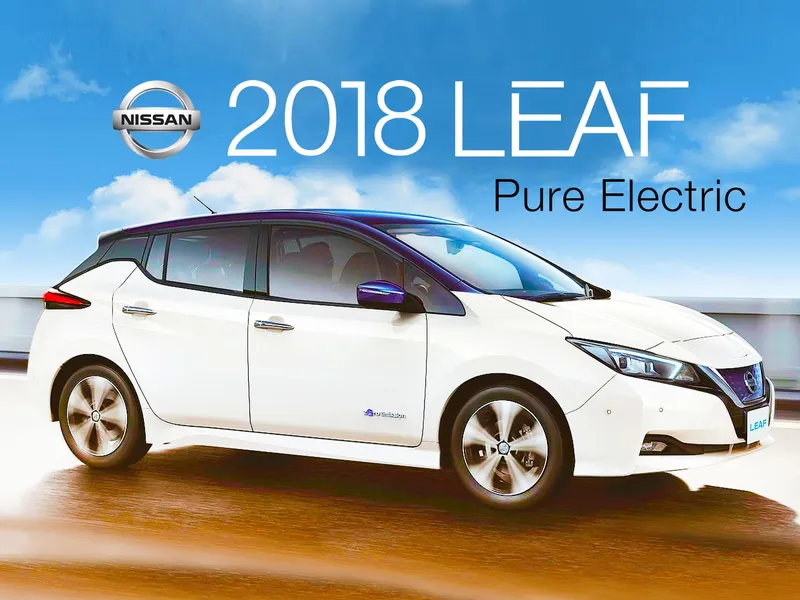
Nissan Leaf
The Next Generation Nissan Leaf has been unveiled and will be available for lease and purchase in October of 2018.
The redesigned Leaf is more powerful than the outgoing model, providing 147 horsepower and 236 pound-feet of torque; an increase of 40 horsepower and 49 pound-feet compared to the current model. Next Gen Leaf uses a 40-kWh battery pack good for 150 miles of driving range on a single charge (up from the current 30 kWh and 107 miles of range). For the 2019 model year, Nissan will release an "e-Plus" version of the Leaf with more power and a higher battery capacity, expected to provide more than 225 miles of driving range.
Leaf's ProPilot Assist and e-Pedal technology are new. ProPilot Assist is a hands-on, single-lane semi-autonomous driving system that basically combines stop-and-go dynamic cruise control with lane-keeping technology that does most of the acceleration, braking and steering work for you. E-Pedal is a system that allows you to turn on one-pedal driving. It greatly increases the regenerative braking, and will even hold the car on a steep incline, so you almost never need to touch the brake with e-Pedal turned on. Nissan will introduce ProPilot Park, an autonomous parking system, on the Leaf at a later date.
With a starting MSRP of $30,875 (including destination charges), the 2018 Leaf is $690 cheaper than its previous version. That's before the federal tax rebate of $7,500, plus any local incentives. That tax perk won't last forever, though. Nissan has already sold over 112,000 EVs in the U.S., and beginning at 200,000 rebates per automaker, rebates begin stepping down every six months until they're gone.
Reviewer John Voelcker of the Car Connection says: "The 2018 Nissan Leaf is improved in every way over its aged predecessor: it’s better-looking, nicer inside, and has more power and battery range, at a relatively affordable price. The 2018 Nissan Leaf is a restyled version of the world’s best-selling electric car. This year it adopts new designs for the exterior and interior, more battery range, a host of active-safety features, and a price slightly lower than last year’s model. The heavily revised electric car comes in three trim levels: base Leaf S, mid-level Leaf SV, and top-of-the-line Leaf SL. The 2018 Leaf tones down its shape and wears more normal sheet metal. The compact five-door hatchback now shares many styling cues with other recent Nissan designs. Only the plug-port door on the nose and the mushroom-shaped drive selector inside give away its electric drivetrain, and that will likely appeal to many buyers turned off by the previous car’s distinctive, polarizing looks.
The new Leaf gains points in essentially every category, and with a range that’s double that of the first 2011 Leaf, it should be considered by a wider swath of buyers. (This score could rise if the 2018 Leaf does well on crash-safety test rankings from the NHTSA and IIHS.) We consider Nissan’s 2018 Leaf a strong contender as a practical electric car that’s almost $7,000 cheaper than the longer-range Chevrolet Bolt EV. Other contenders including the Ford Focus Electric, Hyundai Ioniq Electric, and Volkswagen e-Golf have less range (114 to 125 miles) and are sold only in limited areas of the U.S. Like the Bolt EV, the Leaf will be available nationwide, starting early in 2018. For those who need more range, a 2019 model with 200 miles or more of range has already been promised. As it is, Nissan is launching the Leaf into a white space between the 125-mile e-Golf, at about the same price, and the more expensive 238-mile Bolt EV."
Recent Posts
- The 2022 Audi Q4 e-Tron SUV combines performance, practicality and luxury
- Ford's 2022 F150 Lightning All-Electric Truck is in high demand
- Legendary Audi performance is at the heart of the 2022 Audi e-tron GT and its RS sibling.
- Meet the Lexus RZ 450e – the luxury brand’s 1st EV
- The 2022 GV60 is Genesis’ first all-electric vehicle

